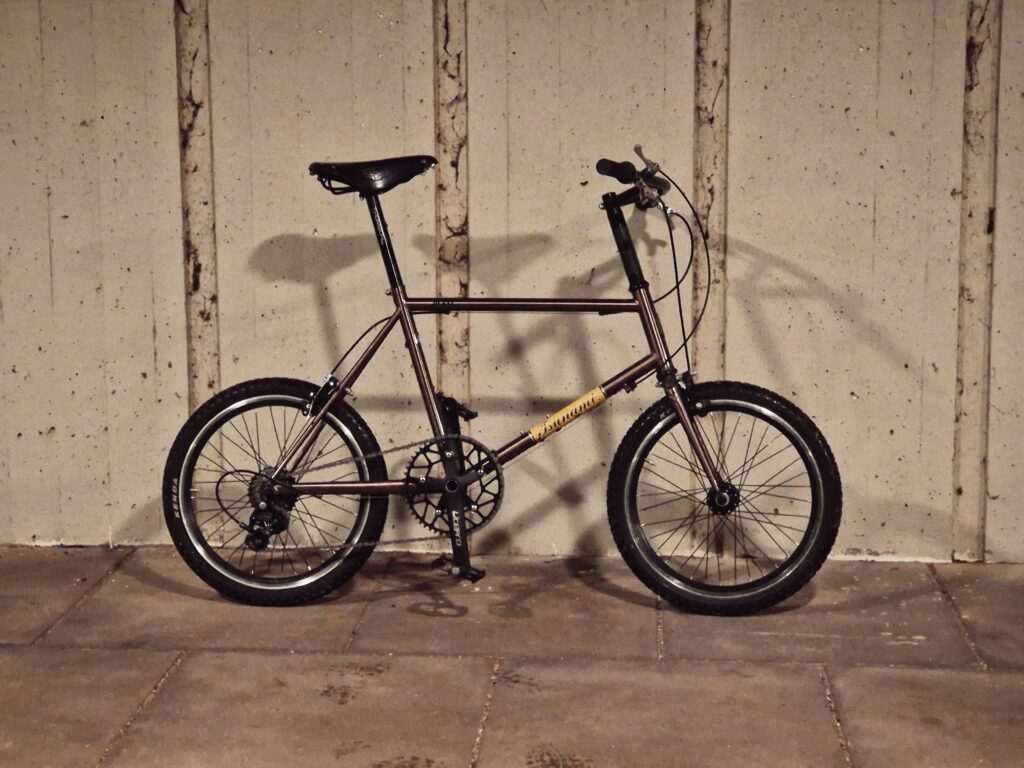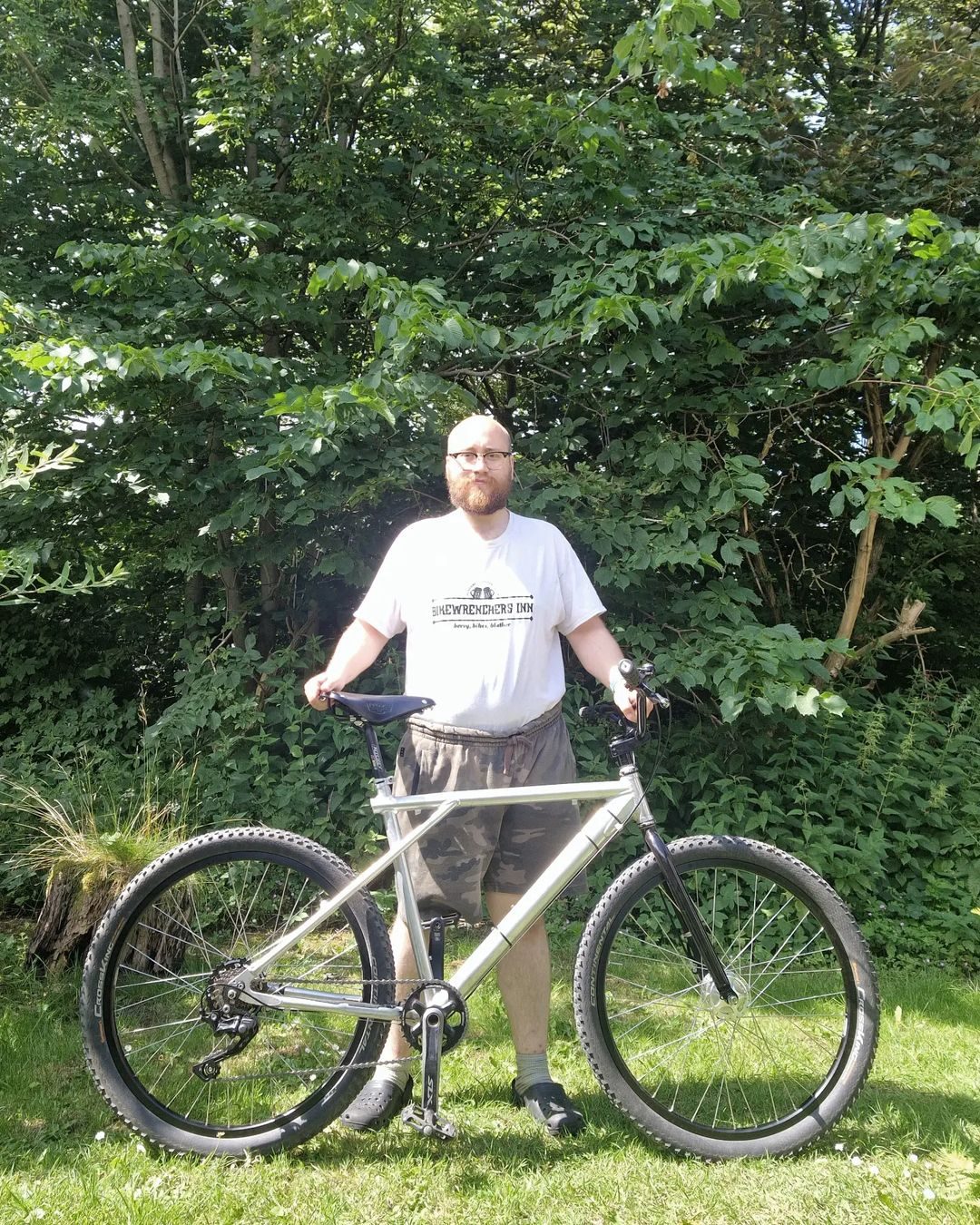Last year I bought a Minivelo frameset from AliExpress. A friend of mine had introduced me to the world of small wheeled bicycles through a thread on Retrobike, where he initially shared folders but since expanded into the smorgasbord of small wheeled goodness. He started including minivelo’s, and as much as I like a folder, something about these minivelo’s really spoke to me. I think it is the fact that they don’t go the ‘whole way’ in terms of compactness, instead sort of bridging between a full size bicycle and a folder, with a geometry that seems to cater more to distance riding. Folder’s seem more aimed at the urban population which uses public transport extensively, where the extreme compactness really shines. But a minivelo, being a rigid welded frameset, seems a capable beast when it comes to power transfer and robustness, while remaining somewhat compact, so it seems the more sensible long-term option for someone who likes to ride a fairly mixed bag of terrain, where the more flexy hinged folders may suffer. This isn’t me suggesting that a folding bike shouldn’t be taken off-road, I know there’s off-road folder’s, but I sort of instinctively have less faith in something that is hinged compared to a one-piece frame. Also, the more capable the folder the larger the price tag.
All of that considered, it seemed pretty clear to me that if I wanted compactness – which I definitely did, because lugging my Karate Monkey round in the tram made me feel like an elephant in a porcelain shop, while also maintaining some peace of mind about durability for the varied riding I do, a minivelo would be the way to go. I actually bought two framesets, one was cheap unbranded high tensile steel one and the other a slightly more luxurious butted 4130 Tsunami. I used Google Images and Instagram as a bit of a moodboard to see what direction I wanted to go.


As I explored the many different builds out there, it became pretty clear to me that a minivelo is basically just a road bike or MTB manufactured by people who were a big fan of Honey, I Shrunk The Kids. Most, if not all the builds, were done using ordinary Road or MTB componentry, with no need for anything specialist. There’s no strange standards to battle with, so apart from the wheelset and slightly more petite mien, there’s really not too much setting them apart from their full size counterparts. That worked for me! I sourced a mix of parts, a lot of it from AliExpress, which I thought fitting considering it’s where I got the frameset. The Tsunami is meant to be a road bike, so I had to use some BMX brake calipers as I knew I’d want to run fatter tyres than recommended. The listing said that the frame wouldn’t be able to take even a 30c, but it turns out that was a very conservative estimate based on them using road brake calipers. The actual clearance on the frame, which was designed for 451 wheels – the bigger cousin to the 406 20″ wheels – was able to handle a big fat 1.7 tyre with knobblies on a 406 rim. I would recommend sticking to 406 wheels on a minivelo, unless you want to be severely limited in terms of tyres, and having to pay a larger premium. 451 is a more exotic, BMX race specific size and though there’s more tyre offerings nowadays, I don’t think it is worth it. Another benefit of 406 is that you can do what I did, and fit fatter tyres for more comfort, if the frame originally was designed for 451 wheels. After fitting the mish mash of parts I ended up with something like this:


From the very first moment I got on it, there was love in the air. It is hard to find words to describe exactly why it feels good, it is just incredibly nimble and responsive. It is very easy to build up speed, which is fantastic in start/stop traffic, largely thanks to the the short wheelbase. But as most of my riding is a blend of on and off road, I was keen to get it unto more gravelly trails. I eventually did and I was surprised, to say the least. I had superb traction and stability due to the very even weight distribution, it is neither front or rear end biased, and as a result I felt very planted on the ground. But it is a bit of a trade off, though the weight distribution is great, due to the shorter wheelbase and lower center of gravity, the smaller wheels do have less overall ground contact when rolling and so can be prone to slipping in loose gravel. But I definitely don’t find my Tsunami lacking in the off-road department. That said, in urban environments, that is where it shines. It is very nice to be able to bring it inner city and navigate through narrow backstreets, go on public transport or traverse pedestrian riddled roads, maneuvering with ease. And you can stash it just about anywhere. I can totally see how in Asian countries, where space is limited, that these minivelo’s could be the only realistic way to have a Road or MTB adjacent bicycle that can easily be stored in your flat.
Safe to say I got hooked pretty quickly even though I was a bit skeptical at first. I wrongfully assumed, like many others, that these minivelo’s were merely kids bikes repurposed. But it couldn’t be further from the truth, a lot of thought has gone into the geometry of these little machines. There’s usually a pretty decent selection of frame sizes, allowing almost everyone to build up something that works for them. This obviously depends on manufacturer, and I will say that the offerings on Asian markets probably won’t work that well for someone around, or over, 2 meters tall. I am 176cm and I picked the largest Tsunami 451 frame I could find, and I wouldn’t want more post or steerer exposed than what I have got there. But there’s always custom routes, and I do think some companies stock sizes that could work for the towering giants gagging for a small wheeled experience. I think the Neutrino by Velo Orange is one of the options for the big’uns out there. But yes, back to the point. I was surprised at how natural it felt to ride my minivelo, obviously it is a bit more cramped than riding any of my “normal sized” bicycles, but nothing you don’t get used to. Also, most of the side effects of a smaller frame can be balanced by the right componentry mix. If you’re not keen on the twitchier nature of a minivelo – which is a given considering the smaller top tube and narrower wheelbase – all you have to do is fit a longer stem and wider bar combination. But honestly I think the twitch is part of what makes them such capable urban bikes, because the steering is so very sensitive it gives you quick maneuverability in crowded spaces. It’s all horses for courses.
I’ve since messed about with the geometry on mine, and now run a shorter reach bar/stem combination:


If your curiosity has been peaked, I definitely recommend giving minivelo’s a go to see if they could work for you. They’re fun to ride and much less of a novelty than I first assumed. If a folder with its increased maintenance and more failure points doesn’t appeal to you, but you still want compactness, I’d say that a minivelo is the answer. And I think the industry is latching on to that, as I’m seeing more and more of them being produced. And as we enter an age of increased urban density in the Western world, combined with a lack of housing, it isn’t unrealistic to assume that some of the challenges Asian countries have faced for decades will be a reality here. So, a need for increased compactness is likely what’s driven the little-known minivelo to our shores. Now I’m not suggesting that small wheeled bicycles don’t have strong roots here in Europe, but I think the numbers speak for themselves, when it comes to the sheer number of small wheeled riders in the Far East. The history on minivelo’s is a bit muddled and is likely an emulgation of many different influences.


But I assume that the early Japanese collaborations of Bridgestone with Alex Moulton and the later Gaap range by Kuwahara paved the way for the minivelo’s we see today, with the modern selection (like my Tsunami) being a bit less eclectic and specialist looking, instead mimicking their full size equivalents in a more understated, elegant way. I prefer that. Anyway, time will tell if these little machines are here to stay, or if they’re merely a fad giving people like me a sense of unique identity for a brief stint.

Leave a Reply